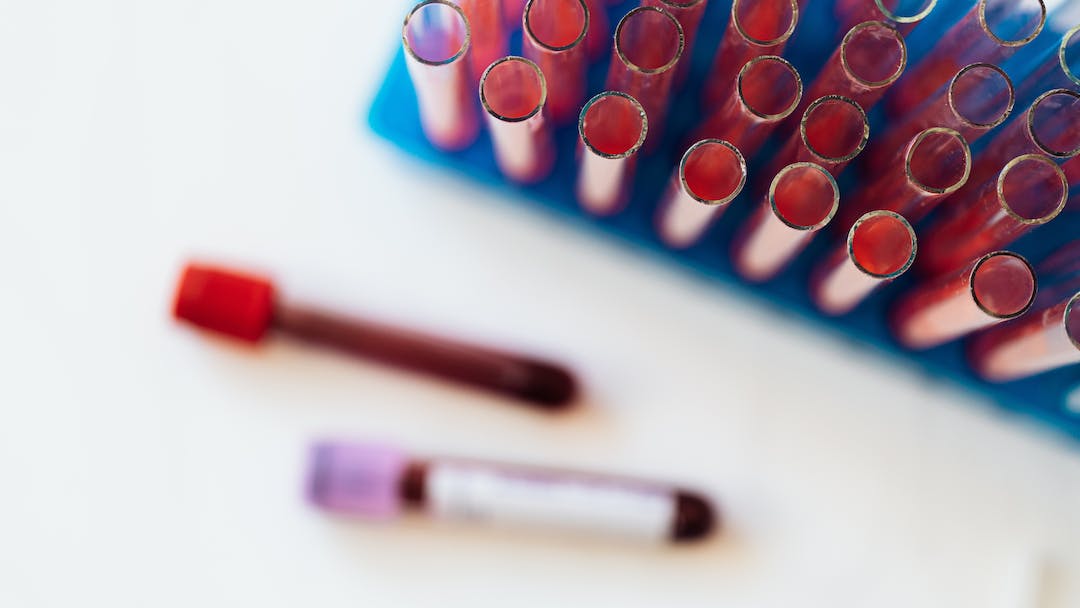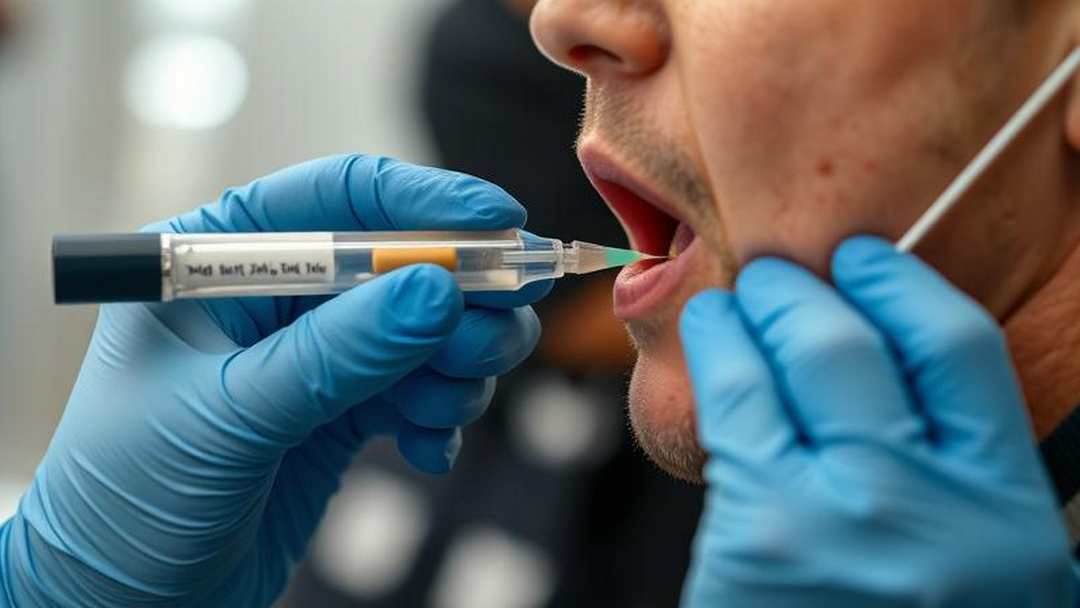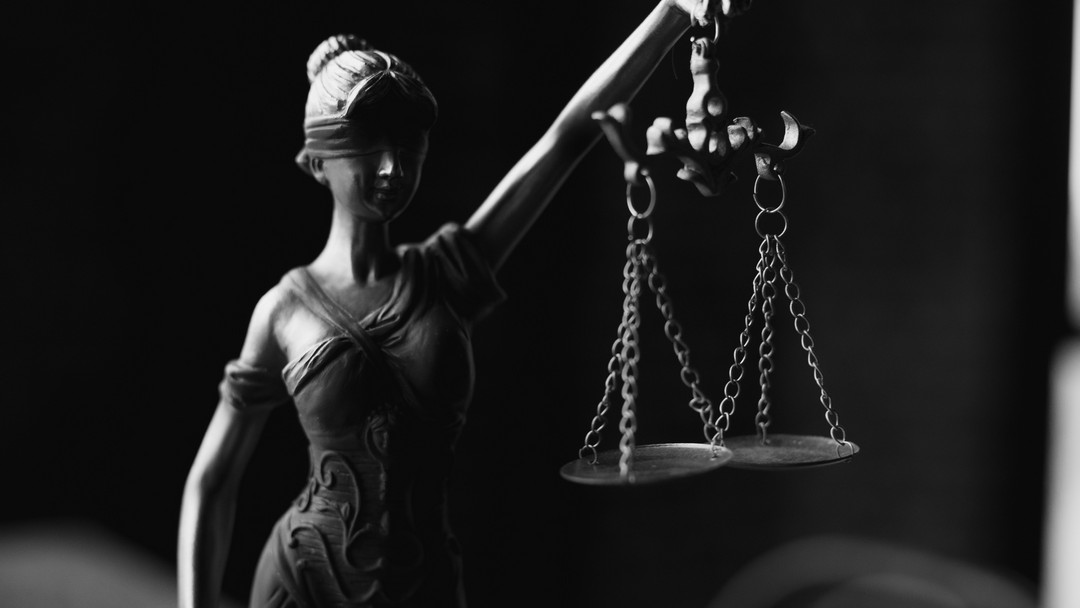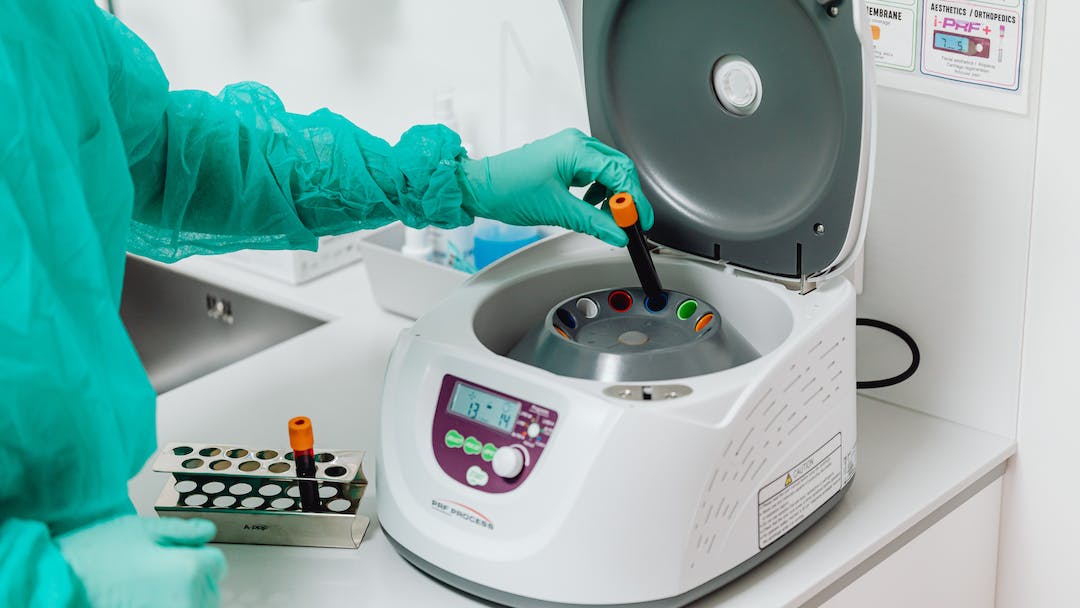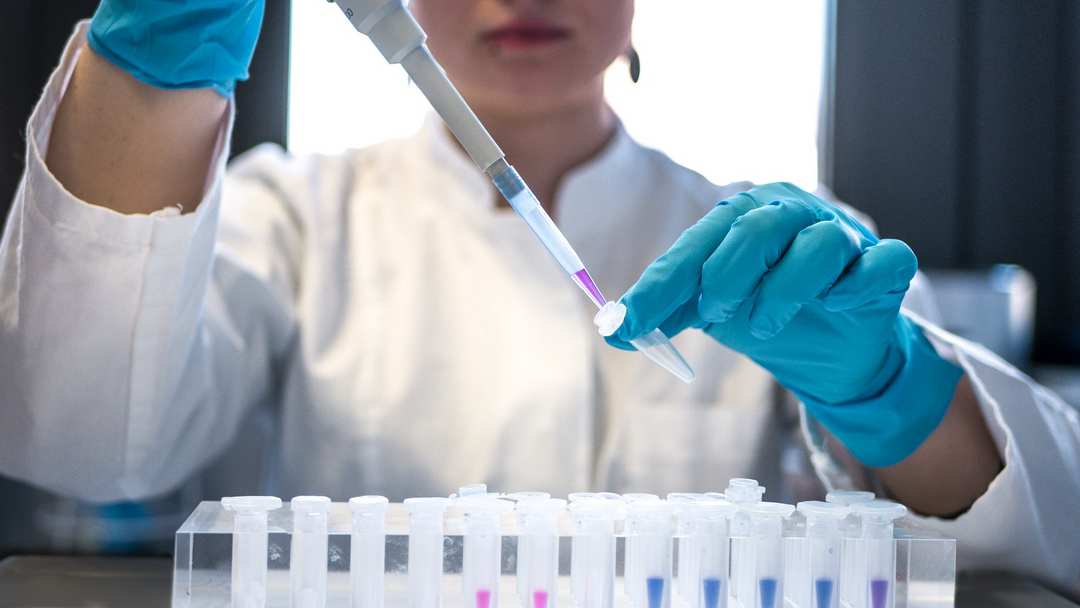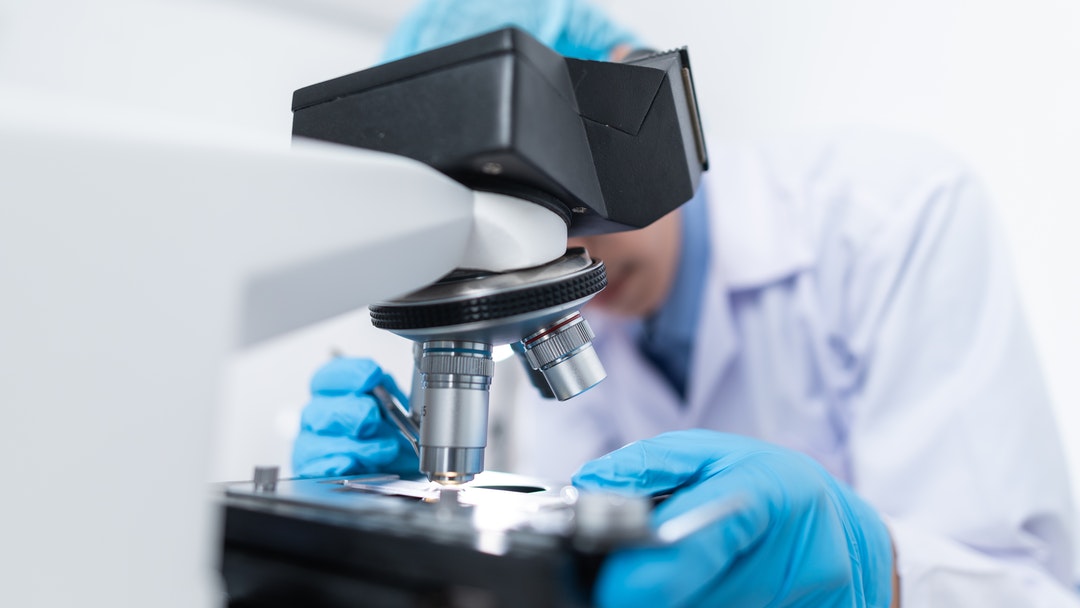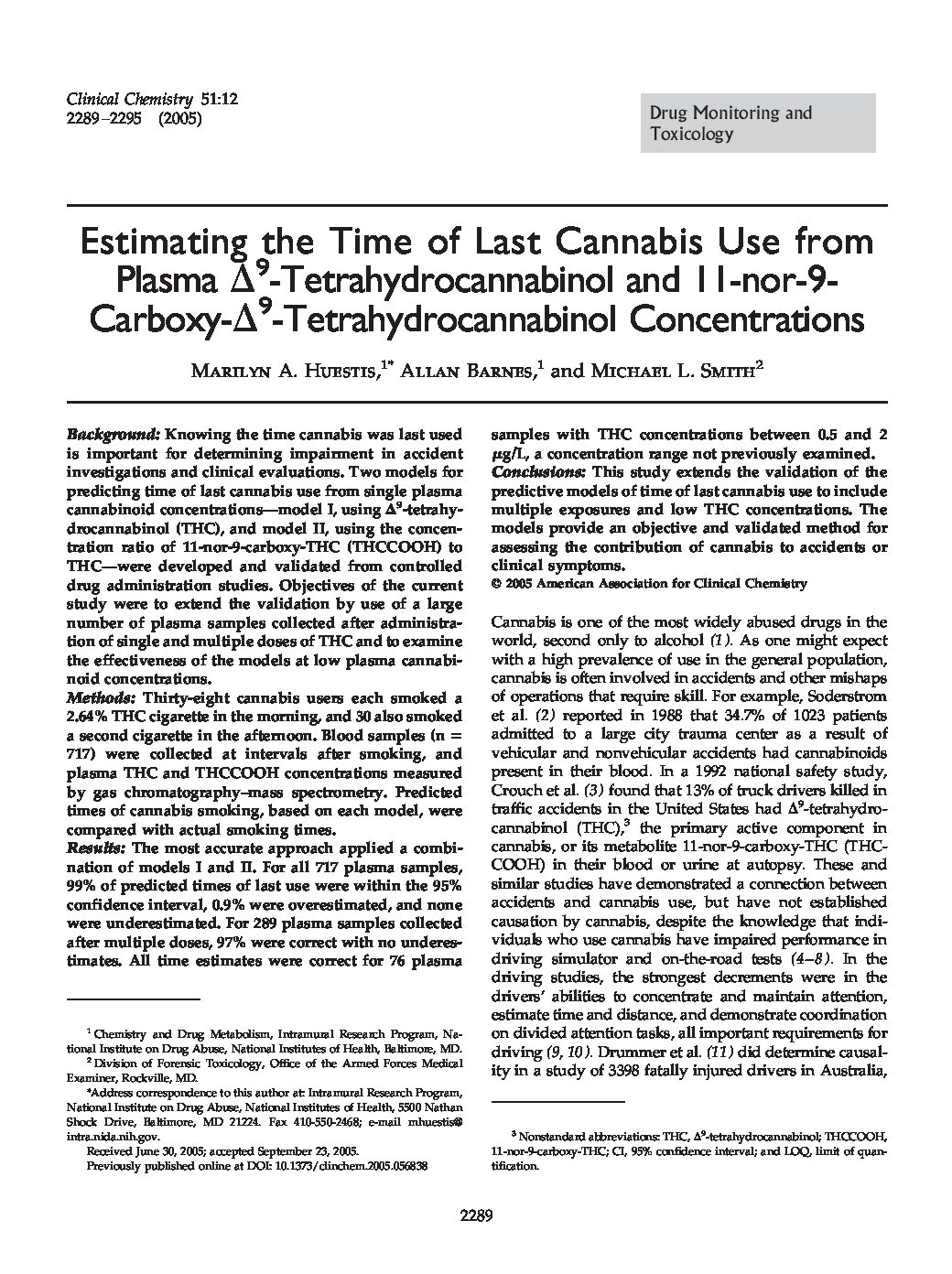
Nov 6, 2023 | Academia, Blog, Driving, DUI, Science
THC Detection in Blood: Challenges and Implications
When it comes to enforcing drugged driving laws, police and employers face a unique challenge with marijuana. Unlike alcohol, which is metabolized and eliminated relatively quickly, THC, the psychoactive compound in marijuana, can remain detectable in the blood for several days or even weeks after use.
This is because THC is highly fat-soluble, meaning that it dissolves easily in fat cells. Once THC is absorbed into the bloodstream, it is distributed throughout the body, including the fat cells. When THC reaches the brain, it binds to cannabinoid receptors, producing the intoxicating effects associated with marijuana use.
As the intoxicating effects of THC wear off, it is released from the brain and redistributed to other tissues, including the fat cells. THC can be stored in fat cells for weeks or even months, and it is released slowly back into the bloodstream over time.
This means that a blood test for THC can detect past marijuana use, even if the individual is no longer under the influence. This poses a challenge for law enforcement and employers, who may want to use blood tests to identify drivers or employees who are currently impaired by marijuana.
Scientific Evidence
A number of studies have investigated the relationship between THC blood levels and impairment. One study found that THC blood levels above 5 ng/mL were associated with an increased risk of impaired driving performance. However, another study found that some individuals with THC blood levels below 5 ng/mL were still impaired, while others with THC blood levels above 5 ng/mL were not impaired.
These findings suggest that THC blood levels are not a reliable indicator of impairment. Other factors, such as individual metabolism, tolerance, and route of administration, can also play a role.
Implications
The limitations of THC blood tests for detecting impairment have important implications for law enforcement and employers. Law enforcement officers should not rely solely on blood tests to determine whether a driver is impaired by marijuana. They should also consider other factors, such as the driver’s behavior and performance on field sobriety tests.
Employers who use blood tests to screen employees for marijuana use should be aware that a positive test result does not necessarily mean that the employee is impaired at work. Employers should have a clear policy in place for responding to positive drug tests, and they should take into account all relevant factors, such as the employee’s job duties and performance.
Conclusion
THC detection in blood is a complex issue with important implications for law enforcement and employers. It is important to understand the limitations of THC blood tests and to use them in conjunction with other information to assess impairment.
Implications
The limitations of THC blood tests for detecting impairment have important implications for law enforcement and employers. Law enforcement officers should not rely solely on blood tests to determine whether a driver is impaired by marijuana. They should also consider other factors, such as the driver’s behavior and performance on field sobriety tests.
Employers who use blood tests to screen employees for marijuana use should be aware that a positive test result does not necessarily mean that the employee is impaired at work. Employers should have a clear policy in place for responding to positive drug tests, and they should take into account all relevant factors, such as the employee’s job duties and performance.
Conclusion
THC detection in blood is a complex issue with important implications for law enforcement and employers. It is important to understand the limitations of THC blood tests and to use them in conjunction with other information to assess impairment.
Conclusion
THC detection in blood is a complex issue with important implications for law enforcement and employers. It is important to understand the limitations of THC blood tests and to use them in conjunction with other information to assess impairment.
Michigan State Police Legal Updates
MSP Legal Update No. 153 (01/2023)
- Search & Seizure: The smell of marihuana, standing alone, no longer constitutes probable cause to search for that substance
- Vehicle Code: Violation for impeding traffic requires evidence the accused’s conduct actually affected the normal flow of traffic.
Legal Update No. 153 (01/2023)
MSP Legal Update No. 150 (01/2022)
- Vehicle Code: Persons under the age of 21 may be prosecuted for operating a motor vehicle with the presence of marihuana in their system
- Criminal Law: Ethnic intimidation based on gender includes harassing or intimidating another person because of the actual or perceived gender of that person.
Legal Update No. 150 (01/2022)
Legal Update No. 148 (09/2021)
Statutes: Code of Criminal Procedure amended to prohibit issuance of appearance tickets to a person arrested for an “operating while intoxicated” offense; Juvenile Law: Individuals who are 17 years of age to be treated as juveniles in criminal proceedings rather than automatically being treated as adults; Did You Know: The mere presence of an unidentified cocaine metabolite is insufficient to prove operation of a vehicle with the presence of “any amount” of cocaine in the body.
Legal Update No. 148 (09/2021)
Legal Update No. 147 (03/2021)
Statutes: The Code of Criminal Procedure amended to require persons arrested for certain misdemeanor and ordinance violations not exceeding 1-year in jail to be released from custody upon issuance and service of an appearance ticket; Vehicle Code: The Michigan Vehicle Code amended to eliminate the requirement to provide an audible signal when overtaking another vehicle.
Legal Update No. 147 (03/2021)

Oct 30, 2023 | Academia, Blog, Driving, Driving While High, Drugged Driving, DUI, DUI First Offense, DUI Second Offense, Science
THC Detection in Blood: A Comprehensive Review
Tetrahydrocannabinol (THC), the main psychoactive compound in marijuana, can remain detectable in the blood for several days or even weeks after use. This is due to the fact that THC is highly fat-soluble, meaning that it dissolves easily in fat cells. Once THC is absorbed into the bloodstream, it is distributed throughout the body, including the fat cells. When THC reaches the brain, it binds to cannabinoid receptors, producing the intoxicating effects associated with marijuana use.
As the intoxicating effects of THC wear off, it is released from the brain and redistributed to other tissues, including the fat cells. THC can be stored in fat cells for weeks or even months, and it is released slowly back into the bloodstream over time. This means that a blood test for THC can detect past marijuana use, even if the individual is no longer under the influence.
Factors that Affect THC Detection in Blood
A number of factors can affect how long THC remains detectable in the blood, including:
- Frequency of use: Chronic marijuana users tend to have higher THC blood levels than occasional users.
- Metabolism: Individuals with faster metabolisms tend to clear THC from their system more quickly.
- Body composition: Individuals with higher body fat percentages tend to have higher THC blood levels.
- Method of use: Different methods of marijuana use can result in different THC blood levels. For example, smoking marijuana tends to result in higher THC blood levels than eating marijuana.
Interpretation of THC Blood Test Results
It is important to note that THC blood levels do not necessarily correlate with impairment. Some individuals with high THC blood levels may not be impaired, while others with low THC blood levels may be impaired. Other factors, such as individual tolerance, route of administration, and time since use, can also play a role.
Additional Scientific Details
In addition to the information above, here are some additional scientific details about THC detection in blood:
- THC is metabolized by the liver into a number of different metabolites, including 11-hydroxy-THC (11-OH-THC). 11-OH-THC is more potent than THC and has a longer half-life, meaning that it remains in the body longer.
- The half-life of THC in the blood ranges from 1.3 to 13 days, depending on the individual’s metabolism and other factors.
- THC can be detected in blood using a variety of analytical methods, including gas chromatography-mass spectrometry (GC-MS) and liquid chromatography-mass spectrometry (LC-MS).
Future Research Directions
Additional research is needed to better understand the relationship between THC blood levels and impairment. Researchers are also working to develop new methods for detecting THC in blood that are more sensitive and specific.
Michigan State Police Legal Updates
MSP Legal Update No. 153 (01/2023)
- Search & Seizure: The smell of marihuana, standing alone, no longer constitutes probable cause to search for that substance
- Vehicle Code: Violation for impeding traffic requires evidence the accused’s conduct actually affected the normal flow of traffic.
Legal Update No. 153 (01/2023)
MSP Legal Update No. 150 (01/2022)
- Vehicle Code: Persons under the age of 21 may be prosecuted for operating a motor vehicle with the presence of marihuana in their system
- Criminal Law: Ethnic intimidation based on gender includes harassing or intimidating another person because of the actual or perceived gender of that person.
Legal Update No. 150 (01/2022)
Legal Update No. 148 (09/2021)
Statutes: Code of Criminal Procedure amended to prohibit issuance of appearance tickets to a person arrested for an “operating while intoxicated” offense; Juvenile Law: Individuals who are 17 years of age to be treated as juveniles in criminal proceedings rather than automatically being treated as adults; Did You Know: The mere presence of an unidentified cocaine metabolite is insufficient to prove operation of a vehicle with the presence of “any amount” of cocaine in the body.
Legal Update No. 148 (09/2021)
Legal Update No. 147 (03/2021)
Statutes: The Code of Criminal Procedure amended to require persons arrested for certain misdemeanor and ordinance violations not exceeding 1-year in jail to be released from custody upon issuance and service of an appearance ticket; Vehicle Code: The Michigan Vehicle Code amended to eliminate the requirement to provide an audible signal when overtaking another vehicle.
Legal Update No. 147 (03/2021)

Apr 30, 2022 | Academia, Blog
Validation of a two-dimensional gas chromatography mass spectrometry method for the simultaneous quantification of cannabidiol, Δ9-tetrahydrocannabinol (THC), 11-hydroxy-THC, and 11-nor-9-carboxy-THC in plasma
Summary of this paper
Our Machine-Learning algorithms scan the text for the most important phrases or passages. These highlights, alongside their respective section titles, are shown below.
Introduction
Cannabis sativa contains over sixty cannabinoids, including cannabidiol (CBD) and Δ 9tetrahydrocannabinol (THC). Although THC is the principal euphoric chemical in cannabis, its therapeutic properties include analgesia, muscle relaxation, anti-emesis, and appetite stimulation. CBD, a non-psychoactive cannabinoid, is an analgesic, anti-convulsant, anxiolytic, anti-oxidant, anti-psychotic, and muscle relaxant [1].
Go To Passage
Calibrators, Quality Control Samples And Internal Standards
Individual stock solutions (1 mg/mL) were diluted in methanol and combined to prepare an intermediate calibration standard (10 μg/mL) containing CBD, THC, 11-OH-THC and THCCOOH. Methanolic working calibrator solutions at 10, 100 and 1000 ng/mL were prepared by dilution of the 10 μg/mL intermediate cannabinoid standard. Daily calibration curves were prepared by fortifying 1.0 mL blank plasma with appropriate amounts of working calibrator solution.
Go To Passage
Two-Dimensional Gas Chromatography Mass Spectrometry
Derivatized extracts (4 μL) were injected in splitless injection mode. Analyte retention times on the primary column were determined by injecting a neat derivatized high concentration cannabinoid standard containing CBD, THC, 11-OH-THC and THCCOOH with column effluent directed to a flame ionization detector (FID). Heart cuts (0.4-0.6 min) containing each analyte peak were made, diverting flow to the secondary column.
Go To Passage
Data Analysis
Data were analyzed with Agilent Chemstation software version D.01.00. Analytes were identified by comparing retention times (± 0.15 minutes) and qualifier ion ratios (± 20%) to average calibrator values obtained in the same run. Quantification was determined by the ratio of target analyte peak area to corresponding internal standard peak area.
Go To Passage
Method Validation
Extraction efficiency for each analyte was assessed in fortified blank plasma (n = 4) at each QC concentration (0.35, 7.5, 20, and 75 ng/mL). Extraction efficiency was calculated by comparing mean target ion peak areas in samples fortified prior to extraction with samples fortified after extraction, but before evaporation.
Go To Passage
Method Development
Although CBD and THC elute from the secondary column less than one minute apart, a single MS acquisition window was created for CBD and THC ions to manage potential retention time shifts. Also, a new oven temperature ramp was developed for extended retention of analytes on the secondary column to minimize retention time drift (Table 1). Complex oven temperature parameters were required for CBD and THC resolution.
Go To Passage
Method Validation
Imprecision and bias were determined at 0.35, 7.5, 20 ng/mL for all analytes and additionally at 75 ng/mL for THC, 11-OH-THC and THCCOOH. Inter-and intra-assay imprecision (%CV) were <7.8 and <6.4% for all analytes, respectively ( Table 3). The method was highly reproducible and QC samples quantified within ± 9.2% of target.
Go To Passage
Proof Of Method
This validated analytical method was applied to a plasma specimen from a participant enrolled in a controlled CBD and THC administration protocol. The plasma specimen contained 1.1 ng/mL CBD, 3.4 ng/mL THC, 3.6 ng/mL 11-OH-THC and 49.4 ng/mL THCCOOH. Extracted ion chromatograms are shown in Figure 1.
Go To Passage
Discussion
This complex instrumental method should be applicable to multiple biological matrices, following matrix validation, and should be highly useful for clinical research, forensic toxicology, workplace drug testing, and DUID programs. Extracted ion chromatograms from a) blank extracted plasma, b) blank plasma fortified with analytes at the limits of quantification-0.25 ng/mL cannabidiol (CBD), Δ 9tetrahydrocannabinol (THC), 11-nor-9-carboxy-THC (THCCOOH) and 0.125 ng/mL 11hydroxy-THC (11-OH-THC), and c) extracted participant specimen from Sativex ® administration a . Arrows indicate retention times of analytes.
Go To Passage
Analyte Target (Ng/Ml)
Intra-assay Imprecision (%CV; n = 5) Bias (% target; n =20) Table 4 Analyte stability (n = 3) & mean extraction efficiencies (n = 4) for cannabidiol (CBD), Δ 9 -tetrahydrocannabinol (THC), 11-hydroxy-THC (11-OH-THC) and 11-nor-9-carboxy-THC (THCCOOH) in plasma.
Go To Passage

Apr 28, 2022 | Academia, Blog
Summary of this paper
Our Machine-Learning algorithms scan the text for the most important phrases or passages. These highlights, alongside their respective section titles, are shown below.
Section 1
A sensitive and specific breathalyzer for D9-tetrahydrocannabinol (THC) is being developed to determine recent cannabis intake.
Cannabinoid Markers
Anti-doping: drug testing in sports to deter athletes from ingesting prohibited drugs to achieve an unfair advantage in competition. Cannabinoids: a class of closely related compounds of the cannabis plant including D9tetrahydrocannabinol (THC, the primary psychoactive chemical in cannabis), more than 100 other structurally related chemicals in the plant, and the endocannabinoid neurotransmitters produced by the human body and many other living organisms, as well as synthetic cannabinoids produced by clandestine chemists, all of which interact with cannabinoid receptors. Cannabinoid disposition: the movement of cannabinoids from the blood into tissues, urine, feces, and bile, as well as into alternative matrices such as oral fluid, sweat and hair.
Urine Markers
When studying THCCOOH urinary excretion in frequent cannabis users, our laboratory group observed positive urine tests for weeks after last use, making it difficult to determine if individuals were abstaining or relapsing in drug treatment [35]. Studying cannabinoid distribution in frequent cannabis users is difficult because ethical and safety concerns prohibit administering the expected amount and frequency of cannabis taken by this population. Nevertheless, this has led to several studies where every urine sample can be analyzed for THCCOOH and creatinine during sustained abstinence to determine THCCOOH pharmacokinetics in frequent users [36].
Hair Markers
In addition, contamination of hair with THC but not THCCOOH by side-stream smoke was reported [52]. Recently, one study reported that THC, THCCOOH, and the THC precursor, D9-tetrahydrocannabinolic acid A, could all be present in hair samples from non-consuming individuals owing to transfer of cannabinoids from cannabis consumers via their hands, sebum/sweat, or cannabis smoke (e. g., exhaled) [53]. Given the poor incorporation of THC in hair and the possibility of contamination from environmental smoke, THCCOOH is considered to be the best hair marker for identifying cannabis use.
Sweat Markers
In one study, THC was quantified in sweat patches from frequent users during sustained abstinence. In many frequent cannabis users only the patch applied during the week abstinence had initiated was positive for THC, and in other patches that were applied the second, third, and fourth weeks of abstinence patch cannabinoids documented extended excretion of THC. However, no THC was found in test patches following oral ingestion of up to 14.8 mg of THC [54].
Breath Markers
THC was removed selectively from the filter and quantified by LC-MS/MS; breath samples from 18 chronic and 11 occasional cannabis users were examined following smoking of a 6.5% THC cigarette [56]. THC 50 pg/filter was detected up to 4 h after cannabis smoking in frequent cannabis users and for a shorter time in occasional users. Thus, while breath is a good matrix for identifying recent cannabis use, no THCCOOH has been identified in breath [56].
Synthetic Cannabinoid Markers
LC-MS/MS screening for new synthetic cannabinoids in a targeted method is a good approach and an achievable one based on the available instrumentation and personnel resources to identify NPS markers, but this approach is also limited by the time that is necessary to keep analytical methods current with newly marketed synthetic cannabinoid compounds, and by the constant need for new reference standards that may not yet be available [63,64]. Unfortunately, this is almost an impossible task. A different approach utilizes HR-MS and a consistent acquisition program to facilitate the addition of newly introduced NPS [9].
Challenges In Interpreting Cannabinoid Use Findings
Other challenges for interpreting cannabinoid results comprise the windows of cannabinoid detection that vary by the biological matrix tested and the analyte(s) selected for monitoring. In this manuscript we have discussed the importance of recent use markers to identify the timeframe of cannabinoid intake, especially in chronic frequent cannabis users. Blood is considered to be the biological matrix that best reflects ongoing pharmacological effects, but blood cannabinoid concentrations decrease rapidly.
Concluding Remarks
Data on drug delivery through these new methods does not yet exist, making it impossible to know what new markers might be available and how to interpret their concentrations and toxicity. The need for behavioral and biological cannabinoid markers is expanding with cannabis medicalization and legalization. Therapeutic drug monitoring of effective cannabinoid pharmacotherapies will be required in the future when new cannabinoids are proven safe and efficacious.
Outstanding Questions
What are the major factors differentiating cannabinoid pharmacokinetics in frequent and occasional cannabis users?
Komorn Law Social Media
Recent Posts
Tag Cloud
2021
BMMR
cannabis
CBD
corruption. prosecutors
dispensary
Driving
DUI
forfeiture
gun rights
hemp
komornlaw
lara
law enforcement abuse
laws
Legalization
marijuana
Medical Marijuana
Michigan
michigan laws
michigan news
MMFLA
MRA
news
police
politics
science
usa news
us supreme court
Your Rights
DISCLAIMER
This post may contain re-posted content, opinions, comments, ads, third party posts, outdated information, posts from disgruntled persons, posts from those with agendas and general internet BS. Therefore…Before you believe anything on the internet regarding anything – do your research on Official Government and State Sites, Call the Michigan State Police, Check the State Attorney General Website and Consult an Attorney – Use Your Brain.

Apr 27, 2022 | Academia, Blog
Estimating the Time of Last Cannabis Use from Plasma 9-Tetrahydrocannabinol and 11-nor-9-Carboxy- 9-Tetrahydrocannabinol Concentrations
Summary of this paper
Our Machine-Learning algorithms scan the text for the most important phrases or passages. These highlights, alongside their respective section titles, are shown below.
Section 1
First samples were collected at 1 min after smoking and at frequent intervals up to 168 h. From these data, the authors developed 2 models to predict time of last cannabis use within 95% confidence intervals (CIs). The first model computed the elapsed time between smoking cannabis and blood collection based on plasma THC concentration alone, whereas the second model used the plasma THCCOOH/THC concentration ratio. They applied the models to results from all published studies at the time that reported THC and/or THCCOOH concentrations measured by either RIA or gas chromatography-mass spectrometry with either internal or external standardiza-tion.Go To Passage
Materials And Methods Participants And Study Design
At 0900 on the day of testing, participants received a single oral dose of placebo (n ϭ 10) or up to 90 mg of rimonabant. Two hours later, they smoked a cannabis cigarette containing 2.64% THC by weight, estimated to contain ϳ20 mg of THC. The number of puffs and time between puffs were standardized.Go To Passage
Hiring a lawyer is an expense nobody wants. Not hiring a lawyer can cost you a lifetime of grief.
The decision is yours. Hire a lawyer that will work for you and not for the system. KomornLaw.com
Analytical Method
Model I determined time estimates from plasma THC concentrations and model II from the plasma THCCOOH/THC concentration ratios. The formulas are reproduced below, with t representing the elapsed time in hours between the beginning of cannabis smoking and blood collection, and CI representing the 95% confidence interval for the estimate of t. The subscripts 1 and 2 refer to models I and II, respectively, and brackets indicate the concentrations of THC or THC-COOH in g/L: 123.420 ͮ These equations were developed from cannabinoid concentrations in plasma samples collected for up to 168 h after controlled smoking of a 1.75% and a 3.55% THC cigarette by each of 6 cannabis users residing continuously in a secure clinical research unit (19 ). Drug administration was not initiated until their urine cannabinoid concentrations were Ͻ20 g/L.Go To Passage
Results
The results for predicted elapsed times between the beginning of cannabis smoking and blood collection obtained with model I, model II, and a combination of the models are summarized in Table 2. The conditions for the single cigarette study were similar to those in the study used to produce the models, except that cigarettes contained 2.64% THC instead of either 1.75% or 3.55% THC, and length of inhalation and the time smoke was held in the lungs were not controlled. For model I, Table 2 reflects that, for 392 of 427 samples collected from 38 individuals after they began smoking the first cigarette, the observed time fell within the predicted range of elapsed time.Go To Passage
Discussion
Other studies also have shown that cannabis users tend to titrate their dose of drug to maintain the level of intoxication they Table 3. Predicted elapsed time between cannabis smoking and blood collection with plasma THC between 0.5 and 2.0 g/L and THCCOOH >2.5 g/L. prefer (20 ).Go To Passage

Apr 22, 2022 | Academia, Blog
Summary of this paper
Our Machine-Learning algorithms scan the text for the most important phrases or passages. These highlights, alongside their respective section titles, are shown below.
Introduction
To our knowledge, there have been no studies of deposition of cannabinoids in human hair following controlled administration of cannabis or THC. Most studies rely on self-reports of cannabis use. In cases where individuals have reasons to hide their drug use, self-report can be unreliable [21].Go To Passage
Subjects
They provided written informed consent to take part in controlled oral and smoked drug administration studies evaluating the pharmacokinetics and pharmacodynamics of cannabis. Subjects completed a questionnaire regarding drug use habits and had hair collected before and after drug administration. The National Institute on Drug Abuse Institutional Review Board approved the randomized, double blind, double dummy, placebo-controlled clinical studies and subjects were compensated for participation. Go To Passage
Clinical Research Protocol
The two highest doses were in the last month of administration. The total THC administered was 116 mg. Hair specimens were collected at the end of the 10-week period 7-10 days after the last dose was administered.Go To Passage
Hair Collection Protocol
For the purposes of this investigation and in accordance with routine hair testing practices, the first 3.9 cm of hair closest to the scalp was analyzed to reveal drug use within the last three months. A total of 53 hair specimens were collected. Hair specimens were randomized and blinded prior to analysis at American Medical Laboratories (currently Quest Diagnostics), Las Vegas, NV. Go To Passage
Gcmsms Analysis For Thc And Thccooh In Hair
Calibration samples contained 5 and 0.5 pg/mg THC and THCCOOH, respectively. Controls in certified negative hair matrix were prepared at 0, 3.0 and 7.0 pg THC/mg hair and 0, 0.3 and 0.7 pg THCCOOH/mg hair. A blind quality control sample at a concentration within the linear range was also included with each analytical batch. Go To Passage
When you need an attorney to represent your Cannabis Business who has the experience and intimate knowledge of the industry – Take a good look at Komorn Law PLLC – a law firm that has been on the front line defending the future of cannabis both medical, recreational and in the justice system providing legal defense services.
Immunoassay For Cannabinoids In Hair
It was adapted and validated for the analysis of cannabinoids in human hair. The LOD of the assay was 2 pg THC equivalents/mg and a cutoff concentration of 5 pg THC equivalents/mg hair was used to screen all specimens. Intra-and interassay precisions at the cutoff concentration were 1.7 % and 9.3 %, respectively. Go To Passage
Statistical Tests
Several procedures for detecting use of cannabis or THC were evaluated. We determined the fraction of specimens that were positive using each of the following criteria: GCMSMS for THC ≥ LOQ, GCMSMS for THCCOOH ≥ LOQ, immunoassay cannabinoids ≥ 5 pg THC equivalents/mg hair, and both immunoassay and THCCOOH ≥ respective cutoff concentrations. Fisher’s exact test, two-tailed, was used to compare the fractions of positive specimens, i.e. detection rates, for daily and non-daily users, AA and C subjects, and to test for independence of detection rates for subjects before and after smoked cannabis [22]. Go To Passage
Results
For those specimens with detectable cannabinoids, the range of concentrations for THC was 3.4 to > 100 pg/mg of hair and for THCCOOH 0.10 (the LOQ) to 7.3 pg/mg hair (Table 1). THC and THCCOOH concentrations were positively correlated (r = 0.38, p < 0.01, Pearson’s product moment correlation, excluding the subject with > 100 pg THC/mg hair). Median THC and THCCOOH concentrations were higher for daily users and AA subjects, but elevations were not statistically significant (Mann-Whitney Rank Sum Test, all p > 0.2, see Figures 1 and 2). Go To Passage
Discussion
For many drugs the parent compound is in much higher concentration in hair than water-soluble metabolites and this is also true for cannabinoids. Concentrations ranged from 3.4 to > 100 pg THC/mg hair compared to 0.10 to 7.3 pg THCCOOH/mg hair. THC concentrations compared well with those reported by other investigators [7,8,10], while THCCOOH concentrations were similar to those reported by Moore et al. Go To Passage
Conclusions
THC and THCCOOH concentrations were positively correlated (r = 0.38, p < 0.01, Pearson’s product moment correlation). Using an immunoassay cutoff concentration of 5 pg THC equivalents/mg hair, 83% of specimens that screened positive were confirmed by GCMSMS at a cutoff concentration of 0.1 pg THCCOOH/mg hair. Concentrations of (a) Δ 9 -tetrahydrocannbinol (THC) and (b) 11-nor-Δ 9tetrahydrocannbinol-9-carboxylic acid (THCCOOH) in hair of cannabis users. Go To Passage
Source
